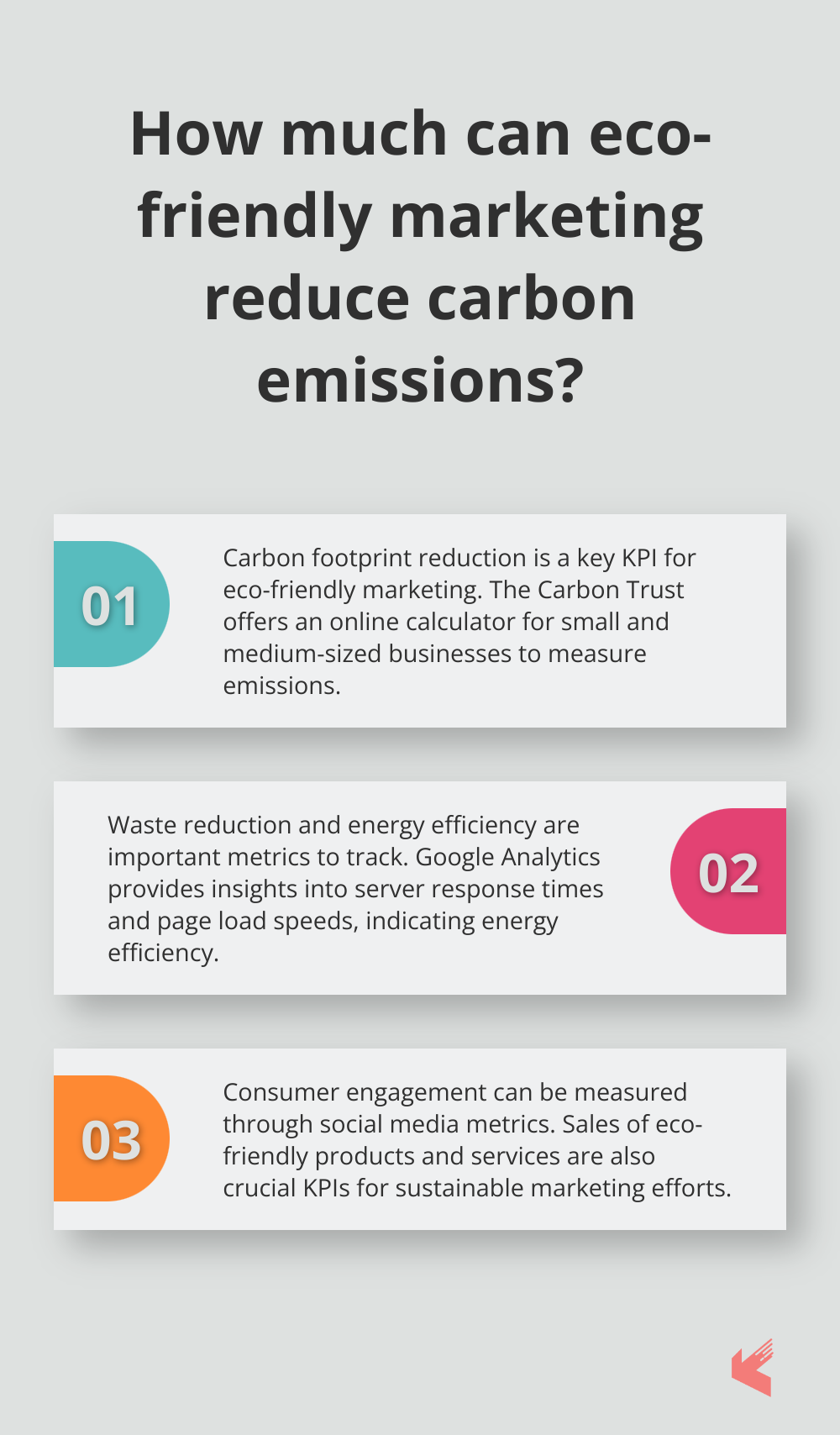Bei Karma Works Marketing beobachten wir einen starken Anstieg der Nachfrage nach Öko-Marketinglösungen. Unternehmen erkennen, dass nachhaltige Praktiken nicht nur gut für den Planeten, sondern auch für das Geschäftsergebnis sind.
In diesem Beitrag untersuchen wir, wie Unternehmen umweltfreundliche Marketingstrategien umsetzen können, die umweltbewusste Verbraucher ansprechen. Wir behandeln praktische Schritte, von digitalen Ansätzen bis hin zu nachhaltigen Verpackungen, die einen echten Beitrag zur Reduzierung der Umweltauswirkungen Ihres Marketings leisten können.
Was ist umweltfreundliches Marketing und was sind Öko-Marketinglösungen?
Definition und Bedeutung
Umweltfreundliches Marketing fördert Produkte, Dienstleistungen und Markenwerte und minimiert gleichzeitig die Umweltbelastung. Es geht über die bloße Kennzeichnung von Produkten als „grün“ hinaus. Vielmehr erfordert es ein grundlegendes Umdenken in der Verbraucherkommunikation, die die Ressourcen unseres Planeten respektiert.
Die Umweltkosten des herkömmlichen Marketing
Traditionelle Marketingmethoden belasten die Umwelt oft erheblich. Printwerbung beispielsweise trägt zur Abholzung von Wäldern und zur Wasserverschmutzung bei. Laut der American Forest & Paper Association werden in den USA jährlich rund 68 Millionen Bäume für die Papier- und Kartonproduktion abgeholzt. Werbetafeln und andere Außenwerbestrukturen verbrauchen nicht nur Ressourcen, sondern tragen auch zur Umweltverschmutzung bei und können lokale Ökosysteme schädigen.
Digital Marketing: Eine umweltfreundlichere Alternative?
Digitales Marketing wird oft als umweltfreundlichere Option gepriesen, hat aber auch Auswirkungen auf die Umwelt. Rechenzentren, die unsere digitale Welt antreiben, verbrauchen enorme Mengen Energie. Eine Studie schätzt den weltweiten Stromverbrauch, der im kommenden Jahrzehnt auf die Kommunikationstechnologie (CT) zurückzuführen ist. Im Vergleich zu herkömmlichen Methoden bietet digitales Marketing jedoch im Allgemeinen einen geringeren CO2-Fußabdruck und eine gezieltere Reichweite, was es zur bevorzugten Wahl für umweltbewusste Marken macht.
Verbrauchernachfrage treibt den Wandel voran
Der Wandel hin zu umweltfreundlichem Marketing kommt sowohl dem Planeten als auch den Unternehmen zugute. Eine aktuelle IBM-Studie ergab, dass fast sechs von zehn Verbrauchern bereit sind, ihre Einkaufsgewohnheiten zu ändern, um die Umweltbelastung zu reduzieren. Dieses wachsende Verbraucherbewusstsein veranlasst Marken, nachhaltigere Praktiken anzuwenden, auch in ihren Marketingbemühungen.
Authentizität: Der Schlüssel zum Erfolg
Verbraucher erkennen zunehmend „Greenwashing“ (die Praxis irreführender Umweltaussagen). Authentisches umweltfreundliches Marketing erfordert einen ganzheitlichen Ansatz, von den Produkten, die Sie verkaufen, bis hin zur Art und Weise, wie Sie darüber kommunizieren. Es geht darum Taten sprechen lassen und die Transparenz Ihres Nachhaltigkeitswegs zu wahren.

Im Folgenden untersuchen wir praktische Schritte, um Ihre Öko-Marketinglösungen umweltverträglicher und kundenorientierter zu gestalten. Im nächsten Abschnitt besprechen wir Strategien zur Umsetzung umweltfreundlicher Marketinglösungen, die Ihren Ansatz verändern und Ihre Zielgruppe ansprechen können.
So machen Sie Ihr Marketing umweltfreundlich
Setzen Sie auf Digital-First Marketing
Die Umstellung auf digitales Marketing bietet erhebliche Umweltvorteile. Digitales Marketing anstelle traditioneller Printmedien wirkt sich positiv auf die Umwelt aus. Digitale Marketingkanäle ermöglichen gezielte, personalisierte Kommunikation bei minimalem Materialverbrauch.

So optimieren Sie Ihre digitalen Bemühungen im Hinblick auf Nachhaltigkeit:
- Verwenden Sie effiziente Codierungspraktiken für Websites und E-Mails, um die Serverlast und den Energieverbrauch zu reduzieren
- Komprimieren Sie Bilder und Videos, um die Datenübertragung zu minimieren
- Diese kleinen Schritte können im Laufe der Zeit zu erheblichen Energieeinsparungen führen
Überdenken Sie Ihre Verpackung und Werbematerialien
Wenn physische Materialien erforderlich sind, entscheiden Sie sich für nachhaltige Alternativen. Wählen Sie recycelte oder biologisch abbaubare Verpackungsmaterialien. Dell hat erfolgreich Verpackungen aus Bambus und Pilzen eingeführt und neue kompostierbare Verpackungsmaterialien entwickelt.

Denken Sie bei Werbeartikeln an nützliche, langlebige Produkte, die nicht auf der Mülldeponie landen. Wiederverwendbare Wasserflaschen, Tragetaschen aus Bio-Baumwolle oder auch digitale Geschenke wie E-Books oder App-Abonnements können Ihre Marke effektiv bewerben und gleichzeitig den Abfall minimieren.
Erstellen Sie zweckorientierte Inhalte
Im modernen Marketing steht der Inhalt im Vordergrund, doch aus ökologischer Sicht sind nicht alle Inhalte gleich.
Konzentrieren Sie sich auf die Erstellung hochwertiger, dauerhafter Inhalte, die Ihrem Publikum einen langfristigen Mehrwert bieten. Dieser Ansatz reduziert den Bedarf an ständiger Content-Produktion und trägt dazu bei, Ihre Marke als Vordenker in Sachen Nachhaltigkeit zu etablieren.
Berücksichtigen Sie bei der Produktion von Videoinhalten die Umweltauswirkungen. Entscheiden Sie sich nach Möglichkeit für Interviews oder Animationen aus der Ferne statt für ressourcenintensive Dreharbeiten vor Ort. Die BBC geht mit gutem Beispiel voran und hat sich für alle ihre Fernsehproduktionen zur Albert-Zertifizierung verpflichtet, um sicherzustellen, dass sie hohe Nachhaltigkeitsstandards erfüllen.
Partner für Wirkung
Die Zusammenarbeit mit umweltbewussten Organisationen kann Ihre umweltfreundlichen Marketingbemühungen verstärken. Suchen Sie nach Partnerschaften, die zu Ihren Markenwerten passen und sinnvolle Veränderungen bewirken können. Beispielsweise hat Adidas in Zusammenarbeit mit Parley for the Oceans eine Schuhlinie aus recyceltem Meeresplastik entwickelt und so ein Umweltproblem in mehrere Öko-Marketinglösungen verwandelt.
Karma Works Marketing ist spezialisiert auf die Vernetzung von Marken durch zielgerichtete Partnerschaften, die sowohl die Marketingwirkung als auch die Nachhaltigkeitsbemühungen verbessern. Unser Netzwerk umweltbewusster Organisationen kann dazu beitragen, die Umweltfreundlichkeit Ihrer Marke zu steigern und gleichzeitig einen echten Unterschied zu machen.
Die Umsetzung dieser Strategien erfordert Engagement und Kreativität, doch die potenziellen Vorteile sind beträchtlich. Sie reduzieren Ihren ökologischen Fußabdruck und sprechen die wachsende Gruppe umweltbewusster Verbraucher an.
Im weiteren Verlauf ist es wichtig zu überlegen, wie sich die Wirkung dieser umweltfreundlichen Marketingmaßnahmen messen lässt. Im nächsten Abschnitt werden wichtige Leistungsindikatoren und Tools zur Verfolgung Ihrer Fortschritte im nachhaltigen Marketing vorgestellt.
Messen von Öko-Marketing-Lösungen für den Erfolg
Definieren von Key Performance Indicators (KPIs)
Um die Wirkung Ihrer umweltfreundlichen Marketingbemühungen zu messen, müssen Sie klare KPIs festlegen. Dazu gehören beispielsweise:
- Reduzierung des CO2-Fußabdrucks: Berechnen Sie Ihre Emissionen aus Brennstoffen und Prozessen sowie aus zugekauftem Strom ganz einfach mit diesem Online-Tool für kleine und mittlere Unternehmen.
- Abfallreduzierung: Messen Sie die Verringerung des physischen Abfalls, der durch Ihre Marketingkampagnen entsteht (z. B. reduzierter Papierverbrauch oder weniger Verpackungsmüll).
- Energieeffizienz: Überwachen Sie den Energieverbrauch Ihrer digitalen Marketingaktivitäten. Google Analytics bietet Einblicke in Serverantwortzeiten und Seitenladegeschwindigkeiten, die auf die Energieeffizienz hinweisen können.
- Kundenengagement: Verfolgen Sie Kennzahlen wie Erwähnungen, Shares und Kommentare in sozialen Medien zu Ihren nachhaltigen Initiativen. Sprout Social bietet hierfür umfassende Social-Listening-Tools.
- Umsatz mit umweltfreundlichen Produkten: Messen Sie gegebenenfalls die Umsatzsteigerung Ihrer nachhaltigen Produktlinien oder Dienstleistungen.
Nutzung von Technologie zur Wirkungsverfolgung
Verschiedene Tools können Ihnen dabei helfen, Ihre umweltfreundlichen Marketingbemühungen zu verfolgen und zu analysieren:
- Salesforce Sustainability Cloud: Diese Plattform hilft Unternehmen dabei, ihre Umweltauswirkungen bei verschiedenen Geschäftsbereichen (einschließlich Marketing) zu verfolgen und zu analysieren.
- GreenAdz: IAS hat sich mit Good-Loop, einer zweckorientierten Werbeplattform, zusammengetan, um Werbetreibenden die Möglichkeit zu bieten, die durch ihre digitalen Werbekampagnen verursachten CO2-Emissionen zu messen.
- Website-CO2-Rechner: Dieses kostenlose Tool schätzt den CO2-Fußabdruck Ihrer Website und hilft Ihnen bei der Optimierung der Energieeffizienz.
- Software zur Lebenszyklusanalyse (LCA): Tools wie SimaPro oder GaBi bieten detaillierte Umweltverträglichkeitsprüfungen Ihrer Produkte und Marketingmaterialien.
Effektive Berichterstattung und Stakeholder-Kommunikation
Transparent Kommunikation über Ihre umweltfreundlichen Initiativen ist unerlässlich. So berichten Sie effektiv über Ihren Fortschritt:
- Erstellen Sie einen Nachhaltigkeitsbericht: Veröffentlichen Sie jährlich einen Bericht, in dem Sie Ihre Umweltziele, -maßnahmen und -fortschritte detailliert darlegen. Die Global Reporting Initiative (GRI) bietet standardisierte Richtlinien für die Nachhaltigkeitsberichterstattung.
- Nutzen Sie die Datenvisualisierung: Tools wie Tableau oder Microsoft Power BI erstellen überzeugende visuelle Darstellungen Ihrer Umweltdaten und machen sie so für Stakeholder leichter zugänglich.
- Integrieren Sie Nachhaltigkeitskennzahlen in regelmäßige Geschäftsberichte: Nehmen Sie neben finanziellen und betrieblichen Kennzahlen auch Umwelt-KPIs in Ihre Quartals- oder Jahresberichte auf.
- Mitarbeiter einbinden: Nutzen Sie interne Kommunikationskanäle, um Ihr Team über Nachhaltigkeitsfortschritte auf dem Laufenden zu halten. Dies kann die Moral stärken und weitere umweltfreundliche Praktiken fördern.
- Nutzen Sie soziale Medien: Teilen Sie Ihre Erfolge und Herausforderungen im Bereich Nachhaltigkeit auf sozialen Plattformen. Diese Transparenz schafft Vertrauen bei den Verbrauchern und zeigt Ihr Engagement für umweltfreundliche Praktiken.
Kontinuierliche Verbesserung und Anpassung
Die Messung und Berichterstattung Ihrer umweltfreundlichen Marketingmaßnahmen erfordert kontinuierliche Aufmerksamkeit. Sie sollten Ihre Kennzahlen und Berichtsmethoden regelmäßig überprüfen und anpassen, um sicherzustellen, dass sie Ihren sich entwickelnden Nachhaltigkeitszielen und den Erwartungen der Stakeholder entsprechen.

Versuchen Sie, anhand der gesammelten Daten Verbesserungspotenziale zu identifizieren. Dieser proaktive Ansatz ermöglicht es Ihnen, Ihre umweltfreundliche Marketingstrategien und maximieren Sie ihre positiven Auswirkungen auf Ihr Unternehmen und die Umwelt.
Abschließende Gedanken
Die Implementierung von Öko-Marketing-Lösungen ist nicht nur ein Trend, sondern für Unternehmen im heutigen umweltbewussten Markt eine Notwendigkeit. Unternehmen können ihre Umweltbelastung reduzieren und umweltbewusste Verbraucher durch digitale Ansätze, nachhaltige Verpackungen und zielgerichtete Inhalte ansprechen. Die langfristigen Vorteile nachhaltiger Marketingpraktiken gehen über den Umweltschutz hinaus und führen zu erhöhter Markentreue, einem verbesserten Ruf und potenziellen Kosteneinsparungen.

Kontinuierliche Messung, Berichterstattung und Verbesserung gewährleisten die Wirksamkeit und Authentizität von Öko-Marketing-Lösungen. Unternehmen können ihre Fortschritte verfolgen und ihre Bemühungen transparent an Stakeholder kommunizieren, indem sie die richtigen Tools und Technologien einsetzen. Dieser Ansatz schafft Vertrauen und Glaubwürdigkeit und positioniert Unternehmen für zukünftigen Erfolg angesichts verschärfter Umweltvorschriften.
Wir bei Karma Works Marketing Wir unterstützen Unternehmen bei der Umstellung auf nachhaltigere Marketingpraktiken. Unsere Expertise im Bereich umweltfreundlicher Marketinglösungen kann Ihrer Marke helfen, positive Wirkung zu erzielen und gleichzeitig Ihre Geschäftsziele zu erreichen. Machen Sie noch heute den ersten Schritt und entdecken Sie, wie Öko-Marketinglösungen Ihr Unternehmen und Ihren Einfluss auf die Welt verändern können.
